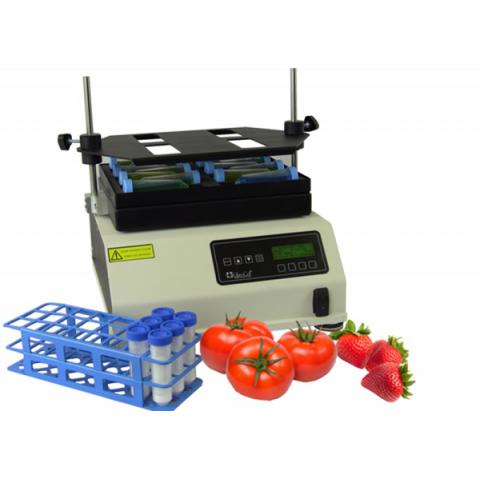商品描述
探索 QuEChERS 实验室混合方法
固相萃取 (SPE) 是一种样品制备方法,涉及通过将化合物悬浮在液体混合物中并促进搅拌来从固体样品中分离化合物。该过程允许研究人员从更广泛的样品基质中分离出所需的分析物。存在各种特定应用的 SPE 方法,但 QuEChERS 方法是首选的实验室混合技术,可最大限度地从有机样品中提取环境污染物。采用 QuEChERS 方法的实验室产品旨在快速、简单、便宜、有效、耐用和安全。
本文将更详细地探讨 QuEChERS 方法的原理:
什么是 QuEChERS 方法?
QuEChERS 实验室混合方法包括通过剧烈的机械摇动来搅拌样品。当得到的样品具有均匀的稠度时,可以通过将样品悬浮在专门的溶剂或制备试剂中并将它们进行离心分离来分配化合物。一旦分析物被有效分离,就可以使用质谱设备进行分析。
QuEChERS 方法的用途是什么?
使用 QuEChERS 方法的实验室混合仪器被接受用于精确评估消耗性有机产品中的农用化学品残留物。农药在敏感生态系统中的流行和全面扩散仍然是一个密集的研究领域。分析师使用多种评估方法来确定人类食物链中农用化学品的数量和浓度。
可以评估动物蛋白中农药和环境污染物的浓度,例如,通过预定义的机械脉冲或持续搅拌将生物样品与溶剂进行均质化。 QuEChERS 方法第一阶段的坚固实验室混合仪器包括涡旋器、振动器和探针混合器。使用该设备的有限混合时间可以提供对生食中存在的农药、农用化学品和其他污染物的准确体积洞察。
涡流振动器能够在短短 10 分钟内从鱼(如黄花鱼和鲑鱼)的均质组织中实现出色程度的污染物提取,而振动实验室混合仪器可以在长达一小时的延长混合时间内实现 100% 的提取。
该方法已用于确定食物链中浓缩农药和农用化学品的水平,使环境研究人员能够准确表征农用化学品的迁移和分散特性。
来自 Equl 的环境监测实验室产品
在 Equl,我们致力于为广泛的研究和开发应用提供一系列强大的实验室仪器。我们的定制混合器已常规应用于使用 QuEChERS 实验室混合方法的环境研究应用。
我们的数字脉冲混频器 (DPM) 是一种精密仪器,具有高达 1500 rpm 的强大轨道速度。它配备执行 QuEChERS 实验室混合,容量为 50 个样品,并显示与速度、脉冲率、占空比和时间相关的指标。我们的 LC 系列具有与 DPM 相同的容量,只是功能较少。
Exploring the QuEChERS Method of Laboratory Mixing
Solid-phase extraction (SPE) is a sample preparation methodology that involves separating compounds from within solid samples by suspending them in a liquid mixture and promoting agitation. This process allows researchers to isolate desirable analytes from the broader sample matrix. Various application specific SPE methods exist, but the QuEChERS method is the preferred laboratory mixing technique for maximum extraction yields of environmental contaminants from organic samples. Laboratory products that operate on the QuEChERS method are designed to be quick, easy, cheap, effective, rugged, and safe.
This article will explore the principles of the QuEChERS method in more detail:
What is the QuEChERS Method?
The QuEChERS method of laboratory mixing involves agitating a sample through vigorous mechanical shaking. When the resultant sample is a homogenous consistency, compounds can be partitioned by suspending samples in a specialized solvent or preparation reagent and subjecting them to centrifugal separation. Once an analyte has been effectively separated, it can be analyzed using mass spectrometry equipment.
What is the QuEChERS Method Used For?
Laboratory mixing instruments that operate on the QuEChERS method are accepted for the precise assessment of agrochemical residuals in consumable organic products. The prevalence and comprehensive dispersion of pesticides through sensitive ecological systems remains an intensive area of research. Analysts use multiple evaluation methods to determine the volume and concentration of agrochemicals in the human food chain.
It is possible to assess the concentration of pesticides and environmental contaminants in animal proteins for example, by homogenizing biological samples with solvents through pre-defined mechanical pulses or sustained agitation. Rugged laboratory mixing instruments for the first stage of the QuEChERS method included vortexers, vibration shakers, and probe blenders. Limited mixing periods with this equipment can provide accurate volumetric insights into the presence of pesticides, agrochemicals, and other contaminants in raw food goods.
Vortex shakers are capable of achieving excellent degrees of contaminant extraction from homogenized tissues of fish such as croaker and salmon in just 10 minutes, while vibration laboratory mixing instrumentation could achieve 100% extraction in extended mixing times of up to an hour.
This methodology has been used to ascertain levels of concentrated pesticides and agrochemicals in the food chain, enabling environmental researchers to accurately characterize agrochemical migration and dispersion properties.
Laboratory Products for Environmental Monitoring from Equl
At Equl, we are committed to supplying a robust range of laboratory instrumentation for broad range of research and development applications. Our custom mixers have been routinely applied for environmental research applications using the QuEChERS method of laboratory mixing.
Our Digital Pulse Mixer (DPM) is a precision instrument with a robust orbiting speed up to 1500 rpm. It is equipped to perform QuEChERS laboratory mixing with capacity of 50 samples and displaying metrics relating to: speed, pulse rate, duty cycle and time. Our LC series has the same capacity as the DPM only with less features.


